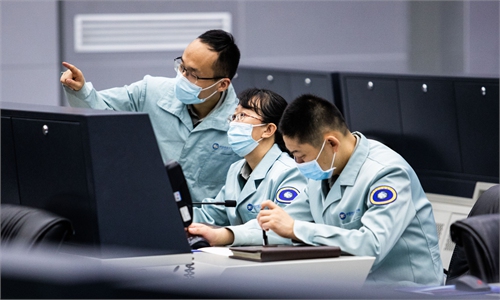 An aerial photo taken on September 15, 2025 shows the Nanning International Convention and Exhibition Center, the venue for the 22nd China-ASEAN Expo (CAEXPO) in Nanning, South China's Guangxi Zhuang Autonomous Region. Photo: VCG
An aerial photo taken on September 15, 2025 shows the Nanning International Convention and Exhibition Center, the venue for the 22nd China-ASEAN Expo (CAEXPO) in Nanning, South China's Guangxi Zhuang Autonomous Region. Photo: VCGIn 2021, President Xi Jinping proposed the joint building of a peaceful, safe and secure, prosperous, beautiful and amicable home, charting the course for China-ASEAN cooperation. Today, China and ASEAN have become a model of regional cooperation marked by mutual support and shared destiny. The data speaks for itself. From January to August this year, trade between China and ASEAN reached $686.78 billion, an 8.6 percent year-on-year increase. As of July, two-way investment between the two sides exceeded $450 billion. The effect of visa-free policies has been significant - from January to August, the number of trips between China and ASEAN exceeded 25 million, up 11.2 percent year on year, truly deepening "hard connectivity" of infrastructure, "soft connectivity" of rules and standards and "heart-to-heart connectivity" between the people.
"The speech script is right in my glasses - you can't see it, but I can." At the opening ceremony, Chen Gang, secretary of the Communist Party of China Committee of the Guangxi Zhuang Autonomous Region, showcased a pair of smart glasses, one of the latest achievements of the China-ASEAN Artificial Intelligence Innovation Cooperation Center. This year's CAEXPO highlights AI empowerment and innovation. The 10,000-square-meter pavilions for artificial intelligence and new-quality productive forces not only witness the implementation of China-ASEAN bilateral agreements but also sketch out a blueprint for upgrading cross-border industrial chains. Through the platform of the CAEXPO, China and neighboring countries "share in real time" the fruits of high-tech development and provide inclusive AI benefit-sharing programs, injecting imagination into high-quality regional cooperation.
How popular is the CAEXPO? Just look at its "spin-offs." Two months before the event, the "AI for All: China-ASEAN" competition, dubbed "AI Super League" by the media, was already trending. From Nanning in Guangxi to Bangkok in Thailand and Kuala Lumpur in Malaysia, AI companies from China and ASEAN countries have been exploring new paths of cooperation. Coinciding with the CAEXPO's opening, high-level meetings such as the China-ASEAN Ministerial Roundtable on Construction and the China-ASEAN Meteorological Forum are also being held. From enabling "low-latency transmission" of meteorological data to jointly advancing "better housing" initiatives and the preservation of urban-rural historical culture, the CAEXPO and its "derivative platforms" continue to enrich and expand the connotations of the China-ASEAN "Nanning Channel."
How close is the cooperation between China and ASEAN? The results of their collaboration are the most convincing evidence. Over the past decade, high-quality Belt and Road cooperation has deepened, resulting in a consensus and documents for building a community with a shared future between China and eight ASEAN countries, including Laos and Cambodia. Emerging fields such as the digital economy and green economy have become new growth points for cooperation. Meanwhile, iconic connectivity projects like the China-Laos Railway and the Jakarta-Bandung High-Speed Railway have brought the construction of the China-ASEAN community with a shared future even closer.
China and ASEAN countries are both part of the Global South, sharing a common pursuit of a better life and the goals of achieving Chinese modernization and modernization in Southeast Asian countries. This has led to a harmonious resonance in the process of expanding opening-up and promoting higher-quality cooperation.
In the context of unilateralism and protectionism continuously impacting global supply chains, the convening of the CAEXPO has set a model for multilateral cooperation, openness, inclusiveness, and mutual benefit. This model is especially significant as it emerges in the Asia-Pacific region, which has a massive economy and the strongest growth vitality, providing encouragement for multilateral governance and the process of economic globalization.
As one of the key activities of the CAEXPO, the ASEAN Plus Three (Japan-China-Republic of Korea) Industrial Chain and Supply Chain Partnering Conference will kick off on September 18 in Nanning, effectively promoting the complementary relationship between the resource industries of China, Japan, South Korea, and ASEAN, ensuring the security of supply chains, and injecting new vitality into regional economic integration.
The impressive achievements of China-ASEAN cooperation serve as the best evidence of the relationship being "the most successful and dynamic model of regional cooperation in the Asia-Pacific." With the comprehensive completion of the negotiations for the China-ASEAN Free Trade Area 3.0, this year's CAEXPO will empower a new future for China-ASEAN cooperation through AI empowerment and innovation, marking a new starting point for high-quality bilateral cooperation











